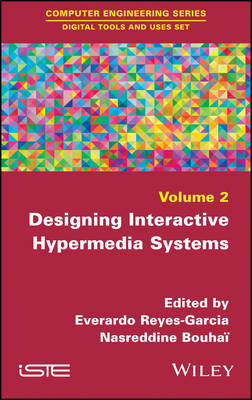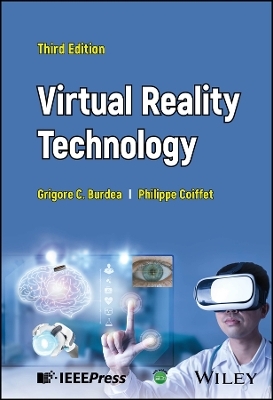
Designing Interactive Hypermedia Systems
ISTE Ltd and John Wiley & Sons Inc (Verlag)
978-1-78630-063-8 (ISBN)
Everardo Reyes-Garcia, Associate Professors at Université Paris 8, France. Nasreddine Bouhaï, Associate Professors at Université Paris 8, France.
Introduction xi
Everado REYES-GARCIA
Chapter 1 From Controversies to Decision-making: Between Argumentation and Digital Writing 1
Orélie DESFRICHES-DORIA
1.1 Introduction 1
1.2 Hypertexts and hypermedia 2
1.3 From decision-making to the study of controversies 3
1.3.1 Definition of the concept of controversy 3
1.3.2 Shifts from one situation to another 4
1.3.3 Controversy representation 5
1.3.4 Some controversy visualization and processing tools and methods 7
1.4 Detailed presentation of Vesta Cosy 9
1.5 What is the content of argument representations? 14
1.5.1 Interactions between the two fields 14
1.5.2 Theoretical approaches to argumentation 16
1.5.3 Hypermedia structure in the process of decision-making map construction with Vesta Cosy 19
1.6 Application of Vesta Cosy to controversy analysis 22
1.6.1 Characterization of the nature of a controversy 22
1.6.2 Methodological principles of controversy analysis 24
1.7 New digital writings with hypermedia 29
1.7.1 Extension of reasoning and paradigm shift 29
1.7.2 Hyperlinked content according to diversified details 30
1.7.3 Disorientation, hypernarrativity and interactions 32
1.8 Conclusion 33
1.9 Bibliography 33
Chapter 2 Training in Digital Writing Through the Prism of Tropisms: Case Studies and Propositions 37
Stéphane CROZAT
2.1 Abstract 37
2.2 Introduction 37
2.3 Issue: theoretical approach to digital technology 38
2.3.1 The possibility of mechanizing intellectual labor 38
2.3.2 Digitization of content 39
2.3.3 “It has been manipulated”: manipulation as a source of digital content 40
2.3.4 “And it will be again”: manipulation as the future of digital content 41
2.4 Proposition: tropisms of digital content 42
2.4.1 The concept of tropism 42
2.4.2 Modeling of functional tendencies of digital objects 44
2.5 Detailed description of tropisms 44
2.5.1 Abstraction: it has been coded and will be recoded 44
2.5.2 Addressing: it has been found and will be found again 45
2.5.3 Connection: it has been transmitted and will be retransmitted 46
2.5.4 Duplication: it has been copied and will be recopied 46
2.5.5 Transformation: it has been changed and will be changed again 47
2.5.6 Universality: it has been integrated and will be reintegrated 48
2.6 Application: training in digital technology with tropisms 48
2.6.1 Training in ordinary digital writing at the University of Technology of Compiègne (UTC) 48
2.6.2 BABA strings (abstraction and polymorphism) 49
2.6.3 SolSys string (staging, hypertextualization) 51
2.6.4 BD string (transclusion, interactivity) 53
2.7 Case study: training in digital writing at IFCAM 53
2.7.1 Introduction to training 53
2.7.2 Training scenario 54
2.7.3 An experience to increase awareness using Etherpad 54
2.7.4 Understanding the properties of digital technology and theoretical content 56
2.7.5 Assignment 1: analysis of practices 57
2.7.6 Part two: reading and writing, second assignment (critical observation) 57
2.8 Perspective: a MOOC “digital literacy” project 57
2.8.1 Defining information literacy 58
2.8.2 Defining digital technology 59
2.8.3 Issue: teaching information literacy 60
2.8.4 Components of teaching information literacy 61
2.8.5 Format: challenges of MOOCs 62
2.8.6 Proposition: content and scenario for an information literacy MOOC 64
2.9 Conclusion and perspectives 65
2.10 Acknowledgments 66
2.11 Further reading 66
2.12 Bibliography 67
Chapter 3 Assessing the Design of Hypermedia Interfaces: Differing Perspectives 69
María Inés LAITANO
3.1 Man–machine interaction 70
3.1.1 Fundamental principles of usability 70
3.1.2 Cognitive engineering 72
3.2 Mediated human activity 74
3.2.1 The Danish school 76
3.2.2 Instrumental psychology 78
3.3 Meaningful systems 80
3.3.1 Semiotic engineering 80
3.3.2 The sociocognitive model 84
3.3.3 Semiotic scenario 86
3.4 Three mediations: three ways of evaluating a design? 88
3.5 Bibliography 93
Chapter 4 Experience Design: Explanation and Best Practices 97
Leslie MATTÉ GANET
4.1 Several problems identified with interface creation 99
4.1.1 Users have difficulty too often 99
4.1.2 An awkward practice of Experience Design 99
4.1.3 A difficult beginning for Experience Design in France 100
4.1.4 Ill-defined jobs 101
4.1.5 Manufacturers at various XD maturity levels 102
4.2 What is good Experience Design? 104
4.3 How does Experience Design work? 106
4.3.1 A method, more than a result 106
4.3.2 Focused on humans 106
4.3.3 A transformed project management 106
4.3.4 New professions 108
4.3.5 Tools in DX 112
4.4 A powerful approach 114
4.4.1 XD protects from rejection 114
4.4.2 XD allows for an important gain in time 115
4.4.3 The XD facilitator 116
4.5 Example of XD contribution to an industrial project 116
4.5.1 Creating the Website with classic project management 117
4.5.2 Revising the Website with XD project management 121
4.6 How can we improve the quality of Experience Design in the ICT industries? 124
4.6.1 A team with an open mind and empathy 124
4.6.2 Co-design, creativity, ideation and respiration 124
4.6.3 Good skills for appropriate responsibilities 125
4.6.4 The systematic presence of the user and going into the field 126
4.6.5 No longer using the term UX 126
4.7 Conclusion 127
4.8 Bibliography 128
Chapter 5 Designing Authoring Software Environments for the Interactive Arts: An Overview of Mobilizing.js 131
Dominique CUNIN
5.1 Research context: artistic practices of interactivity 131
5.1.1 Art and technique in the face of the digital 131
5.1.2 An idea: an authoring software environment 134
5.2 Computer graphics, game engine, art engine? 138
5.2.1 Reusability 138
5.2.2 Game engine: when the metaphor and the objective design the tool 140
5.2.3 Programming for the interactive arts: toward complexity 142
5.2.4 Art engine, an authoring environment possibility? 149
5.3 Mobilizing.js: an attempt at a multi-paradigmatic authoring software environment 151
5.3.1 Artistic technical conduct and critical technical practice 153
5.3.2 An engine with many speeds 157
5.4 Structure and results of Mobilizing.js 163
5.4.1 Overview of a technical sequence 163
5.4.2 Constructing interactivities 170
5.4.3 Interactive, immersive and collaborative system 175
5.5 Conclusion 181
5.6 Bibliography 182
Chapter 6 Clues Anomalies Understanding Detecting Underlying Assumptions and Expected Practices in the Digital Humanities through the AIME Project 185
Donato RICCI, Robin DE MOURAT, Christophe LECLERCQ and Bruno LATOUR
6.1 Abstract 185
6.2 Introduction 186
6.3 AIME and its digital humanities set-up 188
6.4 Methodology: multiplying listening devices 193
6.5 Anomaly family #1: displacements in acknowledging on-and-offline practices ecosystem 197
6.6 Anomaly family #2: interface-driven methodology and its encounters with scholarly publics 199
6.7 Anomaly family #3: the shock of collaboration’s ethoses 204
6.8 Qualifying anomalies for a better understanding of Digital Humanities projects 207
6.9 Bibliography 209
List of Authors 213
Index 215
| Erscheinungsdatum | 20.01.2017 |
|---|---|
| Verlagsort | London |
| Sprache | englisch |
| Maße | 152 x 239 mm |
| Gewicht | 499 g |
| Themenwelt | Informatik ► Office Programme ► Outlook |
| Mathematik / Informatik ► Informatik ► Theorie / Studium | |
| Technik ► Elektrotechnik / Energietechnik | |
| ISBN-10 | 1-78630-063-X / 178630063X |
| ISBN-13 | 978-1-78630-063-8 / 9781786300638 |
| Zustand | Neuware |
| Haben Sie eine Frage zum Produkt? |
aus dem Bereich


